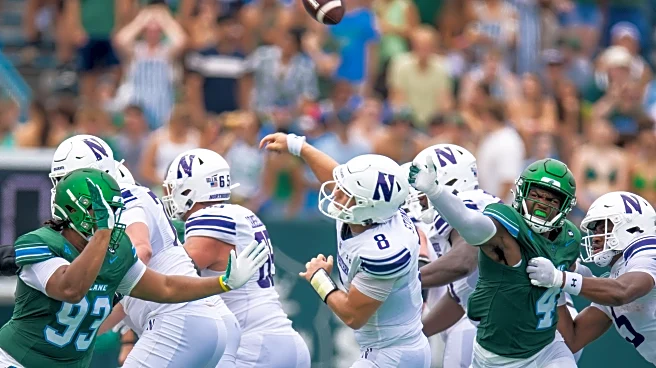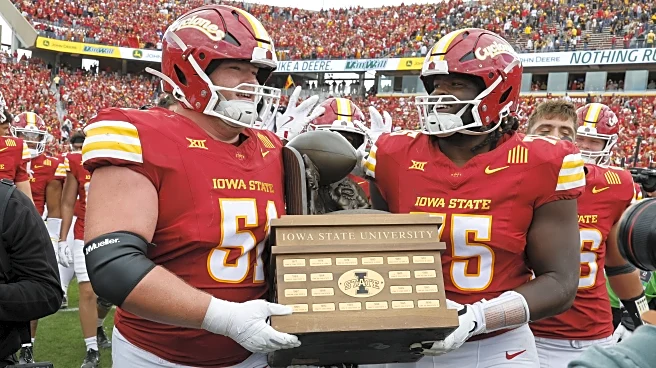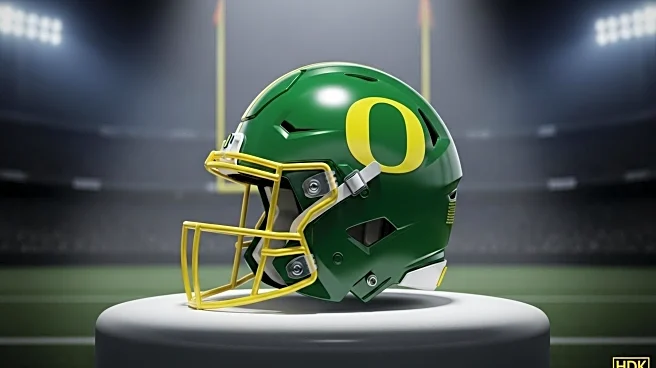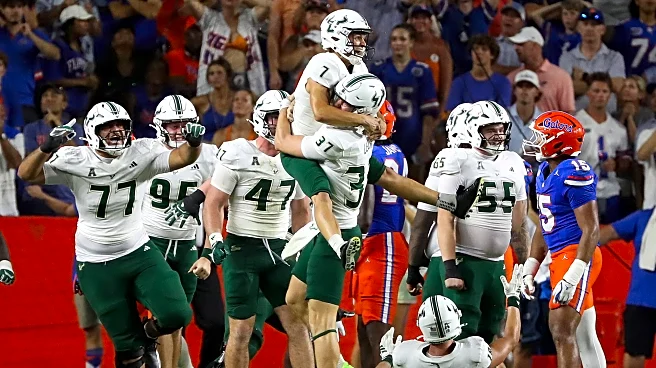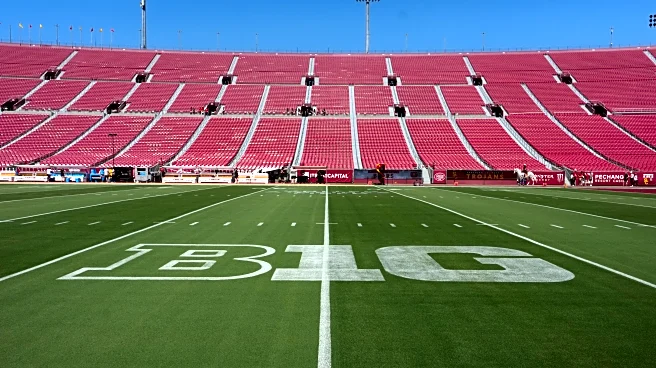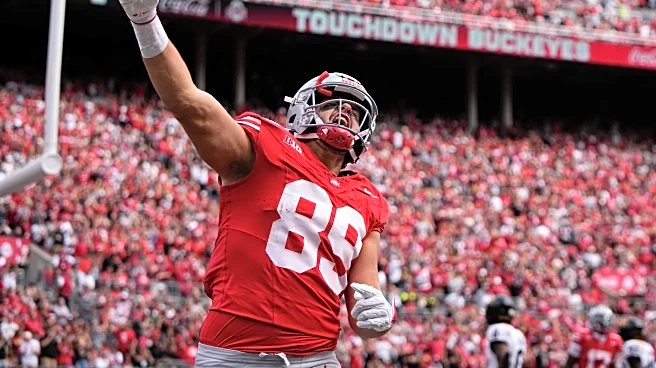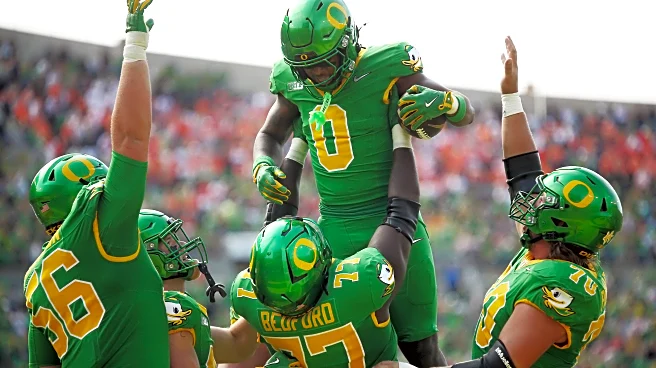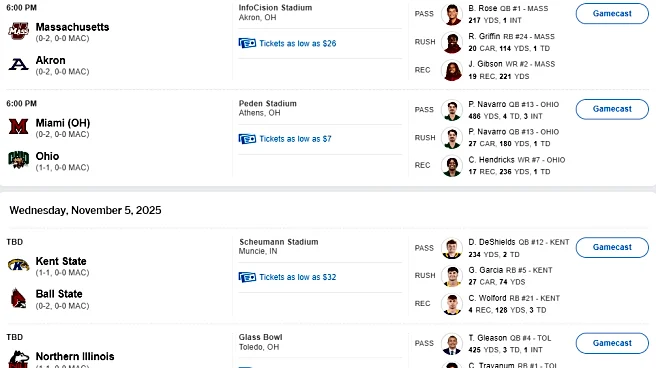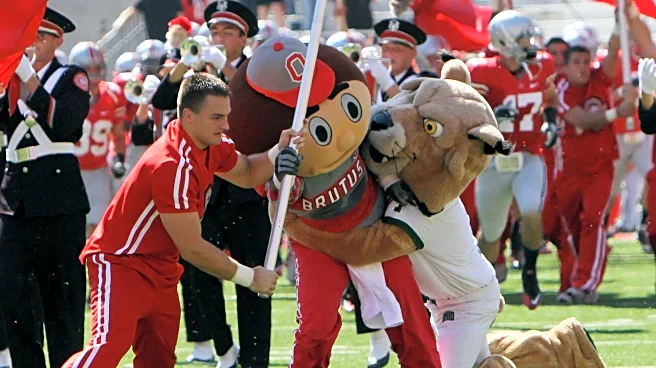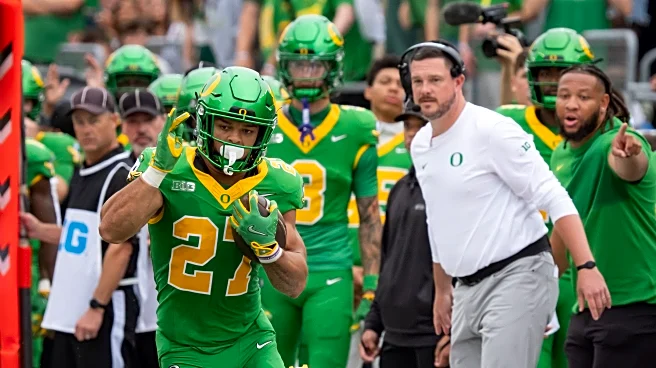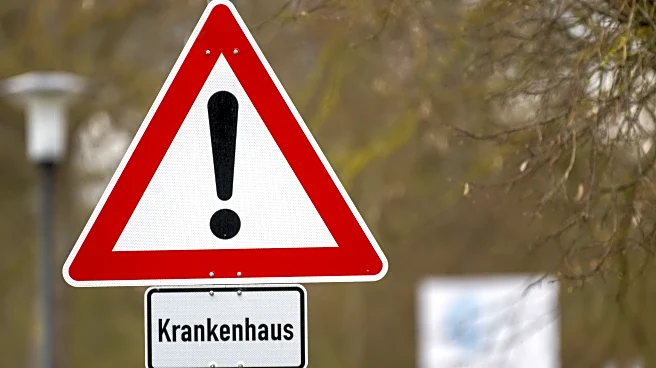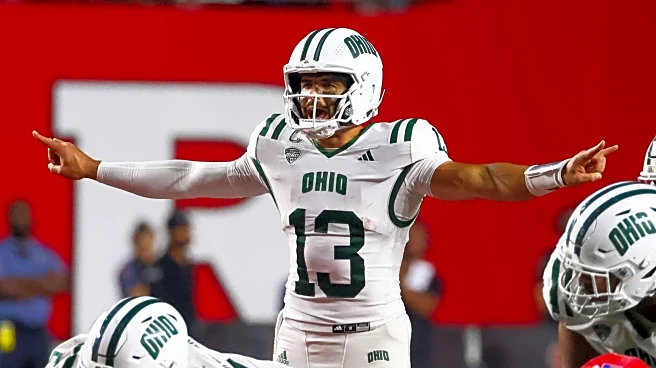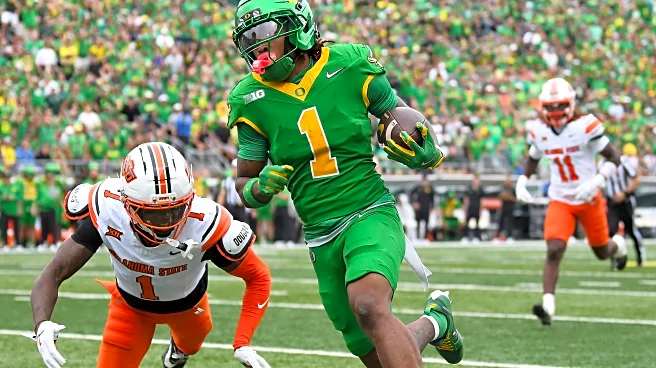Special thanks to Charlie Jacobs of InsideNU for joining me to discuss Northwestern’s roster on this week’s podcast:
Nota bene: Northwestern in 2025 has played one FBS team, Tulane, and one FCS team, Western Illinois. I’ve charted both games for tracking personnel usage and playcalling, but as is customary, all statistics in this article unless specifically noted refer only to FBS competition prior to garbage time. Even though excluding the FCS contest in this case reduces the sample size to a single
game, my experience is that including it would be far more distortive as FCS teams in general just don’t provide comprehensive athletic competition. WIU in particular would offer very poor data to include, as the current Sagarin poll, which uses the same algorithm to rank all 265 Division-I teams together, has the Leathernecks at 240th. For context, UT-Martin — Oklahoma State’s FCS opponent in week 1 which by necessity comprised the film clips in last week’s opponent preview — comes in at 159th, ahead of 10 FBS teams; Montana State is at 80th, ahead of 56 FBS teams including five Power conference teams.
Offense

There’s been quite some hope that 2025 would finally bring an end to the long run of offensive futility at Northwestern that I’ve been observing in film review. To summarize briefly, the Wildcats have been snakebit at the quarterback position where they haven’t had the same signal caller stay healthy and play every game since Clayton Thorson in 2017 (worse, the last to do so and finish with an NCAA passer rating over 130 was Brett Basanez in 2005, and he was still under the contemporary FBS median by three points). For the four years after moving on from longtime coordinator Mick McCall at the end of the 2019 season, they employed Mike Bajakian as playcaller who ran a ponderously slow paced ground & pound offense without the offensive line size or talent to effectively execute it.
New head coach Braun, who took over due to the hazing scandal in the 2023 offseason, fired Bajakian as soon as he could and brought in OC Lujan who’d led South Dakota State to back-to-back national titles running a more modern college offense. But the same quarterback bad luck and inherited offensive line limitations foiled the Wildcats in 2024, only this time without eating so much clock and as Charlie and I discussed on the podcast, the only thing they accomplished was “failing faster” and gassing the defense.
This past offseason, Northwestern brought in transfer #8 QB Stone from SMU, a former mid 4-star who was the starter for the Mustangs in 2023 when he produced an excellent 161.3 passer rating more than a full standard deviation above median, though a significant shoulder injury in the final week of November kept him out of the postseason. The following year Stone — a pocket passer of limited mobility — lost out the QB competition in short order to dual-threat Kevin Jennings, as SMU’s porous offensive line put escapability at a premium.
The projection during the Summer was that if Northwestern’s offensive line had improved and could keep the pressure off of Stone, he should have tools — his own talent as well as the offensive scheme and receivers — to be a top-level passer. Having watched the tape so far in 2025, Charlie and I agreed that this projection holds true as far as it goes – from a clean pocket, Stone is the real deal with a beautiful arc to his throws and great zip from the opposite hash.
Here’s a representative sample of successful passes from the opener:
(Reminder – you can use the button in the lower right corner to control playback speed)
- :00 – The protection holds up for the second and a half or so needed for this quick out, and Stone has properly read the corner’s leverage pre- and post-snap that he’s got free access to the sideline and where to place the ball so the corner has no chance at defending it. The reader can see the arm talent in firing the ball from the opposite hash.
- :08 – The defense is making probably the biggest mistake possible when facing Northwestern given their run game struggles and Stone’s arm, which is getting suckered by the heavy personnel package. Every time in both weeks of 2025 and virtually every time (excluding goalline pushes) in 2024 the Wildcats put 13-pers on the field it was bait for a play-action, here it isolates the corner one-on-one with #10 WR Ahumaraeze and gives him his only catch of the day.
- :26 – About 40% of Northwestern’s successful plays and yardage were from this type of short throw to the curl/flat. Note the QB’s decision instantaneously at the snap when the LB moves from the lane to his favorite target #17 WR Wilde, as well as the man coverage because of the blitz but the DBs playing with cushions – there’s no way the defense is going to stop this quick throw, the blitz can’t get home in time and the DB is too far off to recover.
- :38 – Wilde is enough of a deep threat that he credibly gets the CB to turn his hips and run with him down the sideline on this play-aciton bootleg, leaving the defender unable to recover when Wilde comes back on a well placed ball. Nice moves after the catch for extra yardage.
But by and large the offensive line (and other blockers, running backs in blitz pickup coming in for very low grades) did not keep the pocket clean against Tulane, and under pressure Stone turned in one of the poorest QB performances I’ve ever observed. The final statline came out to a 68.1 passer rating, which is almost impossible, on four interceptions to no touchdowns, under 53% completions, and 4.5 YPA. On the podcast, Charlie brought up some important reminders which add to the explanation of why Stone did so much better — a 177.5 passer rating — the next week against WIU, including that Stone had a lot of rust to knock off between the 2023 injury and sitting out for almost the entirety of the 2024 season, and that on the very first play of week 1 his left tackle whiffed on a block and he got strip sacked which may have rattled his confidence for much of that game.
From watching Stone’s throwing motion, including during the handful of instances in which WIU got pass rushers through the protection the next week and this observation continued to obtain, it seemed clear to me that the big problem is that Stone’s mechanics fall apart entirely when under pressure – rather than escaping or throwing the ball away, he collapses to his back foot, turns his head to the side, and flings the ball wildly at his target cavalierly and without control. The interceptions week 1 were just the tip of the iceberg — and probably being converted from mere incompletions at a higher rate than would be expected due to some very athletic plays by Tulane DBs — the underlying issue is that no one really knows where that ball is going to land.
There’s another issue in the passing offense which has to do with the preferred receiving targets in the tight end and wide receiver corps and some timing or chemistry problems that exist for Stone with certain guys but not others. I suspect this’ll get ironed out sooner or later during the season because we already saw some movement in the target numbers from week 1 to week 2, but Charlie and I were both uncertain about where it stands exactly right now. So for the moment the tape is merely suggestive not conclusory, and I’ll discuss the implications below.
Here’s a representative sample of unsuccessful passing plays from the opener:
- :00 – Here’s just one example of the timing / route-running issues between Stone and Ahumaraeze as he was targeted eight times in the opener and on seven of them the ball was nowhere close, as in this pass which from the downfield blocking (and the RT’s … effort) has to be an RPO screen but Ahumaraeze somehow has in mind a sideline go. Stone turns it into a throwaway when he sees his receiver is in the wind to avoid a grounding flag, though the refs blow it by not flagging the rest of the line for IDP.
- :13 – Stone has a couple choices to convert this 3rd down, and he needs to get rid of the ball since the LG is losing but he has a beat longer than the quickest dumpoff to the short crosser. #88 TE Lines just isn’t fast enough to get around the backer in zone and the drive dies. I suspect Lines’ 2.3 YPT from plays like these led to the experimentation in the next week with other TEs, though geometry and judgment are really the culprits here. Better choices would have been Grove on the other crosser using the ump as a pick, or the RB wheeling out against the DB backpedaling, but Stone balks on both.
- :21 – Poor blitz pickup on both sides from the RB and the LT, and I got used to seeing this throwing motion from Stone under pressure – backfoot, head turned sideways, heaving the ball. This was the third interception of the day.
- :36 – Here’s a simulated pressure with the fieldside OLB bailing into coverage and the boundary safety inserting. It’s picked up very poorly – the center should sense the coverage rotation and with no one to block should be looking to his left, not his right, for the replacement pressure, while the RB is failing his green dog check by leaving the pocket while he has an obvious man to pick up. The LT is in his fourth year as a starter and still hasn’t figured out how much depth to gain against a speed rusher to avoid getting knocked over.
As expected, the top target has been South Dakota State transfer #17 WR Wilde, who’s shown great hands and is clearly on the same page with Stone, to the point where I think Stone seeks him out if he starts getting in a little trouble or locks on a bit if he’s the first read in the pattern. The second most targeted has been #10 WR Ahumaraeze, who had three very nice catches against WIU and is the biggest receiver on the team with great run blocking grades, but in the opener there were some real route running and timing issues and Stone kept missing the connection with Ahumaraeze.
It’s been very difficult to piece together the order for every other target, including the backs and tight ends. #3 WR Covey was a starter in week 1 and got the third most targets, but didn’t play at all in week 2 and Charlie was uncertain of his status. Covey seemed to be replaced by another tall receiver, #80 WR Eligon, who from last year’s tape as a true freshman got very little done until he caught a jaw-dropper of a touchdown. All three of the guys I would consider slot receivers — #20 WR Farrell, #87 WR Grove, and #19 WR Wagner — were in and out of the lineup between weeks and infrequently used. Charlie and I discussed how peculiar it is that Lujan doesn’t seem to want to run screen passes at all and how infrequently slot guys are used, with the most notable play any of the slot guys had being a sweep run that Farrell fumbled on.
Tight ends, on the other hand, have been far more diverse and frequently used than I was expecting. In week 1 the primary pass catcher was #88 TE Lines, who’s on his fifth school in six years, but in week 2 he was used exclusively as a blocker, and as Charlie caught, it was a giveaway that it was a run play if Lines was blocking. #84 TE Welcing and #86 TE Albright (the latter of whom was originally listed as the longsnapper) went from no meaningful targets in week 1 to combining for five in week 2, while walk-on #83 TE Van Buren who didn’t play for Lujan last year has been used consistently as a blocker in both games.
The conclusion Charlie and I came to on the podcast was that the first two weeks have been somewhat experimental with the receiving targets and that the list of primary options will probably narrow in the near future, and as a consequence the timing issues will either get cleaned up or they’ll move on to other guys. Wilde already has a place on that list but I think the rest of it and when it’ll be finalized is unknown – it could be this week, or we might still see further experimentation.
Charlie had some very sad news to relate about the running backs – on the day we recorded, Coach Braun announced that their longtime stud of a starter #4 RB Porter would be out for the season with a leg injury he suffered late in the WIU game. He’d already missed the 2021 season with an ACL tear but came back from it and was by far the most effective back the Wildcats had.
The three they’ve been using had been Porter, #6 RB Himon, and #5 RB Komolafe. Due to offensive line problems, Porter and Himon were both limited to only about a 50% success rate against Tulane … Himon pushed through to a still respectable 4.8 adjusted YPC, but Porter was getting a very impressive 7.5 adjusted YPC.
With Porter out, the question is whether they’ll stick with Himon and Komolafe or try to get back to a three-man rotation by adding one of the freshmen who haven’t played yet, #27 RB Anderson or #24 RB Reeder. When I pressed him for a guess, Charlie said he’d go with Anderson over Reeder if they want a three-back solution since he’s heavier and a little higher rated even though he’s a true freshman while Reeder is a redshirt freshman. But Charlie didn’t have high hopes for either and seemed to think it’ll be mostly Himon and Komolafe with just some Anderson carries sprinkled in for relief.
I think Himon will be fine, he seems to have bulked up a bit and has already improved upon his very poor 29% success rate last year, but I’m pretty close to writing off Komolafe and am pretty skeptical he can carry the now-increased load with Porter out, unfortunately. Last year Komolafe’s numbers were way below the rest of the unit at 31.5% efficiency and 3.5 adjusted YPC. I defended him on last Summer’s podcast as being valuable as a change-of-pace back, which was the stance Charlie took this week, but having observed Komolafe come in at eight percentage points less efficient than Himon or Porter against Tulane and an even worse 3.0 YPC makes me think he won’t be able to carry the load as a workhorse (the week 2 numbers were even more discouraging – Himon and Porter both exceeded 7.0 YPC against WIU, but Komolafe only got 2.8). Charlie disagreed on this point, saying he thinks that Komolafe can even be the primary back once it comes on for him because Komolafe reminds him of a young Porter so much.
Here’s a representative sample of successful rushes from Himon and Komolafe in the opener:
- :00 – NU was nearly perfect in short-yardage rushing in the opener, as the line had size advantages even if they didn’t have technical ones. Note the difference between how the blocking starts with a good solid punch, and how it finishes with that poor 2nd level block from the LG and the TE’s loss of control of the edge – this is indicative of why they’d reliably get 3 yards but rarely anything more.
- :12 – This is the type of thing that Himon wasn’t able to do last year but I was impressed with his physical maturation in this year’s opener – this A-gap run isn’t well blocked by the C or the TE who’s supposed to be leading through the hole, and then the right side followed by the left lose control so more and more defenders are added to the pile … really this should have been stuffed or at most a couple yard gain, but Himon keeps churning his legs and gets five extra yards he wouldn’t have in 2024.
- :25 – Well this is football not freeze tag so that “block” by the LG isn’t going to cut it, but the LT clears the other DT out very well and the 2nd string RT has the best pull of the game (more on that strange situation below) so it’s one-on-one in short yardage and Komolafe is good for the contact.
- :33 – The most successful runs were hitting the D-gaps, using the TEs and bigger wideouts to open the holes while the opposing backers crashed the interior lanes. Good pathing by Himon to delay his bend until after the LB has committed and then get around the mess without losing momentum.
And unsuccessful rushes from the opener:
- :00 – Here the RT and C lose leverage on their blocks right off the snap which immediately kills the play, and the LG had lost too so it wouldn’t have gone anywhere even if they hadn’t. NU kept going back to this wide zone run throughout the game and never executed it successfully.
- :06 – This time the blocks aren’t immediately terrible (although they are eventually terrible) but the play fails because this run design is bonkers. The two strongside TEs get the defense aligned to that side but then they don’t compensate for it with any pullers from the backside – they’re just wasting three backside blocks and letting two free hitters blow up the back. It’s not bait for an option toss either, there’s no backside receiver or even a read.
- :13 – Alright this is more clever, sneaking a boundary run when the formation, motion, and tendencies all say fieldside rollout pass. But the left side is struggling too much so the back is delayed getting through the hole, while the RG gets stuck on his block and fails to get to the 2nd level so the LB is clean to nail him when he does.
- :31 – I wouldn’t normally include a run on 3rd & 21, but this is teach tape on blocking without proper leverage and footwork since the wide spacing lets us see it so clearly. The LT lets his feet freeze when the wide-set defender makes an inside move — which he has to know is coming, it’s an inside run! — and is left to try grabbing with his arm. The RT is doing a better job keeping his feet moving, but he’s much too high on initial contact without his base under him, so he’s pushed deeper and the defender gets under him.
For the offensive line, three of the spots in the lineup have been filled in expected ways (well, one of them had an unfortunate change to due injury but that spot was replaced as anticipated), while two have been bizarre to both Charlie and me.
The expected linemen are #72 LT Tiernan, the starter since 2022, and #60 RG Beerntsen who like Wilde and Lujan came over from South Dakota State. At center, they were returning #69 C Bailey who’s played for OL coach O’Boyle at each place they’ve been at over the last four years starting at Kent State and then Colorado before getting to Northwestern last year, but Bailey is out with injury so they’ve gone with #65 C Carsello instead. That was as planned; Carsello played experimentally in 2023 when the center at the time was having problems to see if he’d be an improvement (he wasn’t) and then as a backup in 2024 when Bailey was out for a bit (that didn’t go any better).
At left guard, we were expecting #74 LG Herzog to resume as starter since he had prior experience and was the starter at the beginning of 2024, but had missed most of the season with a nagging injury that the staff decided not to aggravate so they had him sit out and get fully ready for 2025. But while Herzog doesn’t appear on either of the first two weeks’ league-mandated injury reports, he hasn’t played at all during meaningful time this year, with Charlie telling me that Herzog only played in seven garbage time snaps against WIU after I’d turned the tape off. Instead they’ve gone with #62 LG Oratokhai, a freshman who debuted last year at right guard due to an injury there and got absolutely creamed, and has started out this year playing not much better.
At right tackle it’s been even more mind-boggling and we spent some time on the podcast expressing astonishment over this situation. They brought in #63 RT Gray from Liberty, who I’d previously watched as an effective senior and I thought better fit for Lujan’s offense, so I figured he was a shoo-in to take the RT job. As an alternate, they’d also gotten #75 RT Lewis from Minnesota, who I thought looked fine before losing his job at the position after two weeks in 2024 in what turned out to be part of the Gophers’ OL coach committing a massive managerial screw-up of his line. But like Herzog, Gray was relegated to FCS garbage time without appearing on the injury reports, and Lewis is the second man and much less frequently used in a planned drive-by-drive rotation with the starter #73 RT McGuire, despite McGuire having the worst pass protection grades on the line while Lewis has the best.
I think there are potentially better solutions at every spot on the offensive line, but on the podcast we walked through each one and I agree with Charlie’s logic why the staff is unlikely to make a change at each spot that they might, ranging from fidelity with Tiernan and Beerntsen, the sunk cost of the Oratokhai project, inability at center, and whatever fever grips them at right tackle having yet to break.
Defense

Northwestern’s defense has been the stronger part of the team for quite some time, and despite the coaching changeover has been schematically very stable as a developmental squad. When Braun was brought on as defensive coordinator and then in short order promoted to interim and fulltime head coach, he kept in place the 4-3 / 4-2-5 structure, made virtually no changes to the developmental pipeline, and as the one exception to the clearout of the previous staff retained LB coach McGarigle, elevating him as the replacement DC.
Unsurprisingly, this continuity and lack of churn — very few transfers into or out of the defense, building up upperclassmen and playing them when they’re really ready — had been steadily improving Northwestern’s ranking in F+ advanced statistics as well as their metrics in my own charting-based model by a solid 10 to 20 ranks each year I’d observed them, and I expected them to finish the 2024 season somewhere around the top 25. But instead they fell off to the 50s, and it was pretty difficult to find a reason within the defense why that was – there were some units I had complaints about, naturally, and conference realignment meant different types of offenses that posed novel challenges on the schedule, but I had baked those things into the model and was still expecting a much better finish than they turned in.
I’ve given this quite a bit of thought and with the data so far from the new season as well as talking with Charlie — we had an interesting philosophical discussion about Big Ten defenses on the podcast — I think there are three major components to the miss. The most significant has already been mentioned: the offense picking up the tempo but not the 3rd down conversion or scoring rate just gassed the defense, and the way that the Wildcats’ low recruiting profile manifests is not so much the frontline players but the lack of quality depth behind them, so the defense fell off hard when they kept having to take the field. The second issue was an injury problem in the secondary that caused a redshirt freshman to have to start most of the year who got picked on, resulting in an uptick by a full yard per passing attempt for opposing offenses … I was willing to discount this earlier but if anything secondary injury issues have worsened in 2025 and the matter requires even more attention by staff and those who care to monitor them.
The last issue is that most Big Ten commentators are gaslighting us about the quality of many of the league’s linebackers in general and Northwestern’s in particular. I am disturbed each week that I hear glowing descriptions from such vatniks in regards to backers they see constantly failing to flow to the play, whiffing on tackles, and run without any kind of lateral agility. The Wildcats’ defensive structure compounds this personnel problem by having them attack hyper-aggressively at any hint of the initial run angle, leaving them totally unable to recover if they miss or if the ballcarrier cuts back or if it’s a play that was designed after 1985 and might be a QB option or a pass.
The defensive line looks to be the strongest unit on the team, with full four-man rotations at both tackle and end, some real NFL potential at a couple spots, and not much in the way of surprises from preseason expectations. Furthermore, unlike certain teams which ride the starters to exhaustion and suffer big falloff when they’re forced to bring in the second line or reserve them for specialty packages only, the Wildcats pretty freely rotate at both tackle and end without a whole lot of difference in performance, and keep everybody fresh throughout the game.
At tackle the starters are #1 DT Bastone (wearing #90 last year) and #15 DT Flakes, with #54 DT Gant and #95 DT Story right behind them. Bastone is probably the headliner here with the most havoc stats so far in 2025 (he’d have more in his career if not for an injury last season) but Story was pretty productive last year, and it’s intriguing that the younger Flakes has gotten the starting job, and even younger Gant as a redshirt sophomore has worked his way in to a tight room. The unit has been limited to just those four by injury, however, as upcomer #55 DT D. Roberts seems to be sidelined by injury and the guy the got to replace him, Utah State transfer #94 DT M. Jackson also got hurt. So the only other garbage time tackle we’ve seen has been #56 DT Mayne, whom Charlie said the staff is high on for the future, but I wouldn’t bet on being immediately ready if there’s a need.
Of the ends the weakside starter #91 DE Hubbard likely has the most NFL upside from watching his production the last couple years. Charlie seemed a little disappointed with #4 DE Saka in his first season being promoted from backup to fulltime starter; apparently he was expecting a sack a minute out of the guy, I thought he’s looked fine for a low 4-star coming off the strongside and having to fight through tight ends to get to the QB. Behind them have been #52 DE Hagarty, a covid super-senior who was very productive in 2023 after transferring in from the FCS and Miami-OH before that but missed 2024 with an injury, and #47 DE Kilbane who’s younger but a lot longer than everybody else in the unit and enjoys some leverage advantages. There’s some better depth here than at tackle as they also have #44 DE C. Campbell, a mid 3-star redshirt freshman who’s been getting some run.
The two linebackers who are always on the field are #37 LB Uihlein and #33 LB Brus. When the offense puts a second tight end in the formation, the defense like clockwork and without any exception I’ve ever seen subs out the nickel and subs in the third backer; this year that’s been Purdue transfer #14 LB Karlaftis. In their super heavy goalline defense package, technically a 5-4-2, the fourth additional backer has been Iowa State transfer #45 LB Sadowsky.
Uihlein is the green dot middle backer and a starter last year, part of what’s now a long lineage of nearly identically built pairs of roughly 6’1”, 230 lbs Northwestern backers — Chris Bergin, Paddy Fisher, Blake and Bryce Gallagher, Nate Hall, Xander Mueller — who since 2018 have been racking up tackles, garnering lavish praise from commentators with aesthetically driven notions about ideal Big Ten defenses, and totally ignored on draft day. Brus is the next to be handed that baton, though I still like him better for play recognition and triggering than Karlaftis who graded out terribly at Purdue, and I was pleasantly surprised that the Northwestern staff had the guts to stick the underperforming transfers Karlaftis and Sadowsky at the rotational spots behind the guys they’d developed.
Here’s a representative sample of successfully defended run plays against Tulane:
- :00 – The offense is in 12-pers and the defense is in 4-3. There’s zero hesitation, they play the run without question – look at how immediately the linebacker and safety fire down. Brus picks up a holding flag and the boundary safety kills it off. The defensive tackles aren’t directly engaged at all except inasmuch as they’re absorbing and pulling away the interior o-linemen for cleaner shots by the crashing defenders.
- :19 – This one is a nice job by the line, Flakes blows up the right guard and Hubbard gets under the slicing tight end.
- :33 – Here’s the ideal run defense for the Wildcats, how they want it to go every time – they’ve correctly guessed the direction of the run and the entire line is slanting that way. The 2nd string RB (the starter’s helmet came off on the previous play) keeps going in that direction so he runs right into those blocks, with the frontside edge contained by Brus going around and the backside getting undercut by Hubbard beating the RT. Uihlein is sealed by the guard but it doesn’t matter, the safety is there to clean up.
- :39 – This orbit motion was a non-starter for Tulane, it was a giveaway for the run direction and the defense would get an easy TFL from their aggression going where the play would take them.
And unsuccessfully defended rushes:
- :00 – Tulane consistently used NU’s aggression against them with simple cutback runs (as did other more sophisticated rush offenses in 2024); here the line is slanting themselves completely out of the play following the initial pathing and look at the shoulders of Hubbard, Story, and Bastone – they’re turned perpendicular to the line of scrimmage, easy to control, with their backs to the ballcarrier when he cuts the other way. Meanwhile three tacklers whiff: Uihlein, the nickel run blitzer, and the safety.
- :17 – Again it’s 12-pers vs the 4-3, and an immediate attack by the LB and DB with the edges going very wide and deep immediately. Brus gets picked up by the LG and Uihlein flat misses, but the DB winds through and gets the tackle after a 5-yard gain.
- :23 – Kilbane goes inside and wins which forces the back to bounce, this aggression needs to be backstopped by the guys behind him setting the edge but instead Uihlein, the nickel, and even the replacement field safety (whose entire job is to not do exactly this!) all get greedy and follow the DE inside, leaving the sideline open for a big run. The corner seems outleveraged instead of controlling the sideline too but I didn’t get a good enough camera angle to chide him fully.
- :32 – Here the DL slanting is so aggressively that the back just goes in a straight line down the hashes which takes him behind the heels of the DE Kilbane, who turns around in bewilderment that the run could possibly be going in a different direction. The RT isn’t needed to block him so he can climb to the 2nd level to easily seal off Uihlein and the back gets 10 yards untouched.
Charlie and I spent quite a while discussing the secondary because at least one projected starter has been out with injury since the beginning of the season, and there’s been a significant amount of additional shuffling because of what appeared to be an injury to another projected starter, although there was a strange development in that story late in garbage time during the FCS game. Both of us agreed on the podcast that there’s a wide degree in the quality of play between certain DBs and others — or even for a particular DB, whether he’s at one spot or another — and that the staff has strengths, weaknesses, and potential options to address some vulnerabilities with changes to the lineup if they identify them. But we also agreed that the data we have has been inconclusive about the staff’s preferences or where their hand might be forced, so it’s something of a guessing game as to how the backfield will look on Saturday.
The two solid locks at their positions are #6 DB Fitzgerald at boundary safety and #13 CB Fussell at fieldside corner. Fitzgerald has been at his position for a while, although he moonlighted at nickel for a bit last year and hits hard as a tackler so Charlie entertained one potential alternative solution which moved him to that spot, but Fitzgerald wasn’t great in coverage and I think the opportunity cost is too great so I think he’s going to stay at deep safety where he excels at covering up for others’ deficincies. Fussell was thrown into the fire early last year as a redshirt freshman because the 2023 backup and 2024 projected starter, #7 CB Adeyi, suffered a broken leg and missed the season. Fussell got picked on a bit at the time since he was very green and playing opposite a veteran, but he’s got the experience under his belt now and Charlie said Fussell was his favorite player on the squad.
The plan for the 2025 season at nickel was clearly to go with #2 CB F. Davis, a former high 4-star from the 2020 cycle who’d originally signed with Clemson before transferring to UCF then Jacksonville State. But that plan also contemplated moving Davis over to outside corner since the depth in that room was so thin and letting #9 DB B. Turner, who’d been a backup nickel before, take over the position. They shored up the nickel spot late in the offseason by taking senior #8 DB Tatum from Michigan State, who missed much of last year with an injury but looked fine when he got into relief action against WIU.
That plan B was put into action from the get-go in 2025: Adeyi was listed on the availability report as out in week 1 so Davis has played outside corner during all meaningful reps, with Fussell and backup #12 CB E. Smith rotating at the other spot (Charlie’s assessment on Smith was that he was “okay”, pronounced in the most “not okay” tone I think I’ve ever heard). But here’s the very strange twist: Adeyi came in and played during garbage time in week 2, and to my eyes he looked perfectly healthy, no lost speed at all … and he’s been the projected starter for two straight seasons. Charlie and I talked through multiple potential implications to this, ranging from slow-playing Adeyi’s triumphant return to him simply never being as good as expected and several possibilities in between, each of which might or might not mean they’d be free to return Davis to the nickel position.
Charlie and I agreed that getting someone to replace Turner at nickel would be essential to plugging Northwestern’s biggest explosive play vulnerability, as he’s the lowest graded performer by a large margin in this regard. It’s an unfortunate situation that they’ve been forced into playing a backup so early in the season, although it’s puzzling because both Adeyi and Tatum look to be available so I don’t really know how much they have in fact been forced … the possibility must be confronted that they’ve always had the option to remove Turner from the field and that the staff either correctly or incorrectly has assessed that playing him is their best option, in which case they’re unlikely to change now.
The other injury is to #21 DB Walters, a 2023 high 3-star who’s the highest rated DB Northwestern recruited into the secondary and was the projected field safety. Charlie told me Walters really popped in practices and was looking forward to a great season, but he’s unsure of what exactly the injury is and that the staff has been very tight lipped about the return timeline. In his place has been redshirt junior #18 DB Wallace, who I was initially surprised to see because I’ve watched him for four previous years as a backup and he had middling grades at best, and I frequently see Fitzgerald bail him out from the other side of the field on plays.
I think Wallace also constitutes a vulnerability which might be shored up with some personnel changes, though it’s difficult to predict whether any might happen. Walters’ return is up in the air, and while I think Tatum could do it or even #29 DB Stevens, the true freshman who briefly came in for Wallace when Karlaftis missed a tackle and banged his helmet into Wallace’s (perhaps the most NU linebacker play I’ve ever seen), the staff has had the option to use those replacements for Wallace since the beginning and haven’t.
I pressed Charlie a couple times during the podcast, including on this question, for his impression about the staff’s disposition to self-scouting and its willingness to make changes if something wasn’t working or to stay the course and power through adversity. He demurred every time, and I think I know why – all of us, even the closest and most interested observers of Northwestern football, are still stuck on the essential question about the Coach Braun era: was the 2023 good season or the 2024 bad season the fluke? Only time is going to give us the hindsight to see how his staff processes matters like these, and it’s still too early in 2025 to know what to think yet.
Here’s a representative sample of successfully defended passing plays from the opener:
- :00 – The consistent pattern on my tally sheet is that NU needed to blitz to hurry the QB into a bad throw, but I think not because the d-line was full of scrubs, rather Tulane was a quick-firing offense which used extra blockers to buy another second of pocket time. So NU needed to bring five to take away the double-team, which would usually let one of the pretty good linemen win a one-on-one and get to the QB … here it’s Kilbane beating the RT, as the back can’t help him out since he has to pick up the blitzing backer.
- :06 – Here NU is blitzing five, against a seven-man protection, then brings a sixth as the TE stumbles out into the pattern. The pocket is holding up but it’s definitely getting pushed backwards and the QB’s timer is sped up. I think the WRs have beaten this coverage and a cooler QB would have nailed this pass, so the push paid off for the defense.
- :13 – This just isn’t a smart blitz pickup strategy by the offense, the LG needs to get a move on. With a free rusher coming the QB is hurried into a bad decision and fires a low trajectory ball that’s tipped and nearly picked.
- :20 – Here’s an example of NU showing an obvious man coverage look and the offense trying to manipulate it with a classic route out of the backfield that challenges the LB’s lateral speed (a good bet with these LBs), but the Wildcats for years have demonstrated that they’re much cagier than that and will disguise their coverages and come off, as here when Brus lets the TE go to pursue the ball and the safety fires down instead of getting carried to the corner.
And unsuccessfully defended passes:
- :00 – Everybody does their job here, but given the initial alignment, as soon as the nickel steps down on to the RPO there’s simply no way to avoid giving up a ten yard pass on 1st down (other than prayer that the QB throws the ball into the stands), so I don’t really understand the point of this coverage.
- :07 – This is actually zone coverage (look at the leverage, not the posture, you get used to it after watching NU for a while) so Fussell is supposed to watch for the widest route — the TE on the wheel — not chase the X to the inside. On the high replay angle, we can see that the other side of the field is also having zone coverage issues – the nickel Turner should be midfield so the backer isn’t in tension on the mesh, as it is they’ve got three covering one to the field.
- :28 – We can really see the varying levels on this play. Davis has his outside man locked down, while Turner and Uihlein get absolutely smoked (it’s a touchdown throw to the TE if not for Hubbard’s penetration hurrying the QB). Wallace is the safety over the top of the play but he’s late to trigger, while Fitzpatrick is on the other side and has anticipated it so early that he makes the tackle before Turner even recovers on his coverage.
- :43 – Tulane took advantage of NU’s automatic substitution rules and aggressive rush assumptions to pass out of 12-pers on several occassions. Note how both tight ends release into the pattern for a high/low read but the backers Brus and Uihlein vacate midfield to go after the RB while Hubbard refuses to bail into coverage, leaving only Karlaftis to turn and chase from the backside.
